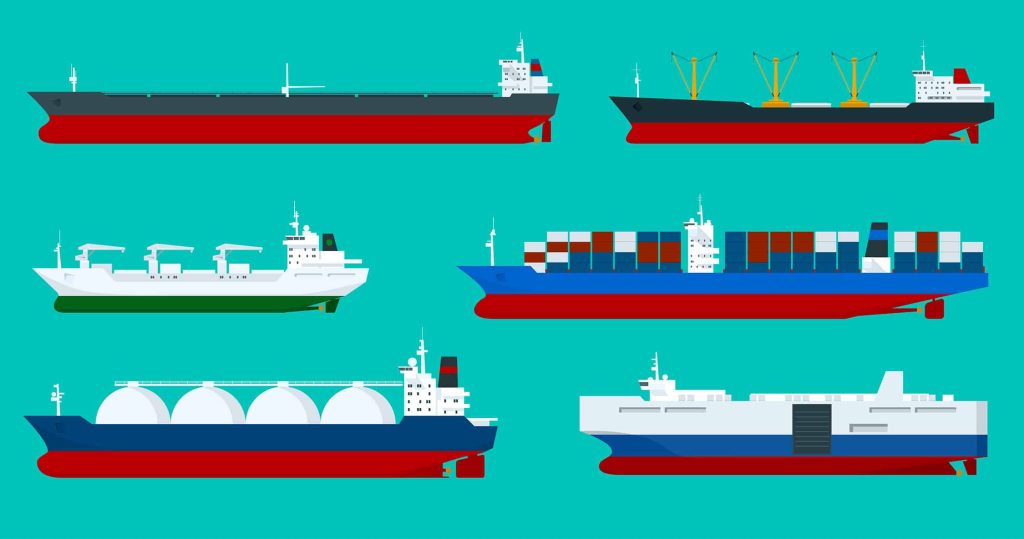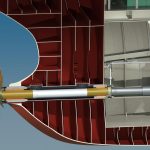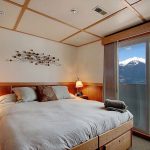All ships have a unique silhouette and this characteristic is often the best means of telling one type of ship from another. Here are some ship silhouettes that are representative of their type, as well as some pointers on how to tell ships apart. At sea such quick identification can be a big aid.
Typing Ships by Their Silhouettes
An incredible assortment of ships sail the planet’s waters. Ranging in size from behemoths like aircraft carriers and supertankers to little fishing trawlers, making sure that accidents are kept to a minimum in an environment where the endless waters and unpredictable weather is no mean feat. Often the first step in deciding what course of action to take when two ships meet at sea is simply to figure out what the respective crews are dealing with. Identifying whether a ship appearing on the horizon is a fishing boat or cargo ship is key in ascertaining the proper attitude towards it – while a big cargo ship is likely to be relatively hard to maneuver and so can be expected to maintain a fairly predictable course, a smaller ship could well turn unexpectedly and pose a collision hazard.
But telling ships apart, even big from small, is not always easy at sea. Size can be deceptive, especially if distance is not clear. And at sea, with no landmarks or sizing clues to work with, it is easy to underestimate or overestimate the size of ships appearing on the horizon. In the Second World War it was not uncommon for scout ships and aircraft to report that they had spotted fleets full of huge battleships, only to later find that they’d seen a squadron of smaller destroyers.
To tell ship types apart in a reliable fashion, typing ships by silhouettes has become a common practice. Different types of vessels exhibit starkly differing physical characteristics that can be noted by the naked eye. From the shape of the deck to the pattern of the superstructure, silhouettes make it easy to tell a navy cruiser apart from a cargo ship.
Supercarriers

Supercarriers are some of the largest and most visually striking ships to behold. Only eleven of them exist, all used by the United States Navy, and all are rather easily identifiable by their flat deck profile broken up only by the aircraft that are parked around it. Fortunately for anyone at sea, these 1,000+ foot, 100,000+ ton behemoths only travel when surrounded by smaller ships and covered by jets and helicopters. Passing ships will know it is there and be guided a safe distance away in short order- no one risks damage to a supercarrier.
Aircraft Carriers

Not ever carrier is a supercarrier – that title is reserved for the biggest aircraft carriers afloat. Many other nations operate fixed wing jet aircraft off smaller carriers whose physical profile fits the slang term “flattop” which is often applied to carriers. One or two boxy conning/flight operations towers set off to one side are pretty much the only feature above the level of the flight deck, which may also be broken up by the silhouetted of numerous helicopters and jets around the deck, a scene befitting what is essentially a mobile airfield.
Tankers

Surprisingly, aircraft carriers are rivaled, within the realm of things meant to float, in size and weight only by supertankers. These nondescript, ubiquitous vessels make modern society possible by moving oil and fuel between production fields and refineries which are often separated by thousands of miles. Identifying supertankers is fairly simple – if it’s big, sits high in the water, has a substantial superstructure located far forward or aft, and doesn’t seem to have distinct shapes above the main deck then it may well be a tanker. The lower in the water it appears to be the more heavily laden with liquid it probably is.
Cargo Ship

Tankers may carry society’s lifeblood- fuel- but cargo ships carry everything else of value that is heavy and shipped in bulk. While airplanes get there faster, cargo ships carry far, far more and remain the most economical means of moving goods over long distances. When loaded, cargo ships are easily identified by the towers of shipping containers stacked on their deck. Their profile sits high even as their hull sinks low in the water. What superstructure they have is minimal and set to the front or rear of the ship.
The problem, as far as identification goes, comes when they aren’t loaded. When it comes to telling the types of ships by silhouette, an empty cargo vessel and tanker look very much alike. Fortunately, it isn’t profitable to send empty cargo ships out to sea. In most cases, even if they’ve just offloaded a massive number of shipping containers from a distant port, they’re getting ready to load some more for transport to their next destination. And in truth, both tankers and cargo ships are so large, loaded or not, that it is best to keep clear.
Cruise Liners

Cruise liners are found all over the world, but especially in places where tourists like to visit. They frequently travel up and down coastlines and can be a problem when coming into a major port. Fortunately they are usually large and quite tall, being effectively floating hotels. Look for a continuous superstructure as the most telling feature.
Battleships

Battleships are an unlikely sight at sea, since only four remain in existence (save for museum pieces) and only two, owned by the United States, could be made seaworthy in a crisis. But just in case, battleships can be told apart from other vessels by their sheer size (rivaling carriers, tankers, and cargo ships) and above all by the big cylindrical tubes that stretch out from the main body of the ship. As the above image aptly demonstrates, even when a battleship is as close to looking like a solid mass against the horizon as it can get, some of those gun barrels stick out. They’re almost a foot and a half in diameter and in better viewing conditions can be seen to be attached to massive turrets located along the vessel’s central axis.
Battlecruisers

The battlecruiser is mostly a forgotten breed, but several ships that could ostensibly be claimed to be battlecruisers are operated by Russia. These revamped members of the Kirov class are nuclear powered and house twenty massive cruise missiles plus a couple hundred surface to air missiles forward of their superstructure. The relatively streamlined superstructure, small guns and helicopter pad aft, sharply rising bow, and long flat area forward of the superstructure is the dead giveaway that this is a Kirov.
Cruisers

Only the United States Navy and Russian Navy still operate cruisers in significant numbers, and they look quite a bit different. The US operates many more than even Russia though, and while Russia’s look a lot like smaller Kirov class battlecruisers or oversized destroyers, US cruisers of the later variants of the Ticonderoga class are distinctive due to their long superstructure bookended by large boxy sections fore and aft and featuring an old-school tripod mast in between. This shape allows them to mount vertical launch systems for missiles fore and aft and the Aegis defense system to control them. This system is characterized by the hexagonal panels located on flat surfaces of the superstructure. This system incorporates long range radar and an automated combat control system.
Guided Missile Destroyers

Guided missile destroyers (often abbreviated DDG) are used by many navies as their primary surface combatant: they are powerful vessels capable of controlling air and sea in the service of the navies that operate them. American and Japanese DDGs are distinctive in that they look a lot like Ticonderoga/Bunker Hill type cruisers, and have boxy superstructures that house the Aegis system. Other navies follow a pattern more like the silhouette above, with a couple mid-caliber guns located fore and aft and a surface to air missile launcher or two set up very close to the long superstructure. They often have a helicopter pad aft as well, and a fairly streamlined appearance.
Anti-Submarine Destroyers

Many destroyers are specialized submarine hunters, and dispense with the Aegis-type systems and surface to air missile launchers in exchange for a hidden punch: high tech sonar systems and enlarged helicopter facilities. Often they have only self-defense weapons to ward off aircraft and ships, but as sub-hunters they are second to none. Indeed, a pair of anti-submarine destroyers operating in tandem, especially if backed up by a pair of helicopters, is every submariner’s worst nightmare.
They are particularly distinctive due to their clean lines – the Udaloy class destroyer pictured above is a bit cluttered relative to other modern designs. The Spruance class of the United States, for example, was criticized for not looking dangerous or well-armed enough even though the members of this class were among the best sub-hunters of all time.
Replenishment Ships

The warships may attract all the attention, but without the aid of dedicated replenishment ships, they rapidly run out of beans, bullets, and gas on long cruises. Navies with global reach only maintain that reach by deploying a fleet of replenishment vessels that carry needed essentials to the warships.
These vessels are quite easy to distinguish when silhouetted against the horizon because of their busy decks. They have any number of protruding hawsers, hoses, and cranes along the edge of their decks and it is not uncommon to see larger bulk items stored above the deck as well. Even if these features were not enough to set them apart from cargo ships, many are equipped with a helicopter pad as well- not a common sight on civilian cargo decks.
Helicopter Carriers

More nations operate small carriers capable of handling only helicopters or VTOL jets than deploy full-on aircraft carriers. Many nations even don’t call them aircraft carriers to avoid negative associations, an example being the Hyuga above which is called a “helicopter destroyer” by the Japanese authorities, much like Russian carriers during the Cold War were called “aircraft carrying cruisers” to avoid legal restrictions set around transiting the Bosporus region.
They are set apart from the larger full-deck carriers as well as similarly sized amphibious warfare ships because they lack a well deck (so sit lower in the water relative to amphibs) and have a superstructure that takes up relatively more deck space than true aircraft carriers. In addition, their helicopters are a dead giveaway if no fixed wing aircraft are seen as well.
Amphibious Warfare Ships

Many nations are turning to ships reminiscent of aircraft carriers for transporting troops. The old style amphibious assault is probably obsolete due to the lethality of modern weapons, so navies that wish to send troops to hostile shores are likely to use helicopters and hovercraft to get the job done. Amphibious warfare ships like the Mistral above are identifiable by how far above the water their flat flight deck is located. This is because their cargo deck and well deck (wet deck for loading/unloading smaller cargo craft) take up a lot of space, and so demand that the ship’s profile be far higher. Also note the presence of cranes- even similarly sized helicopter carriers don’t usually have such prominent cranes.
Frigates and Other Small Warships

Warships smaller than destroyers, such as frigates, corvettes, patrol boats, etc. are fairly difficult to identify. They are some of the hardest types of ships, by silhouette alone, to distinguish from one another. However their sizes and functions remain fairly constant across the navies that use them- and most do. Their profiles are functional and relatively streamlined, which sets them apart as warships. Most have one or two larger guns mounted in turrets, and most also have identifiable missile launchers as well. Many have helicopter decks aft, and lack obvious cranes, cargo spaces, or other deck clutter.
They are small and quick, and fairly maneuverable. They can be some of the more common ships to be involved in collisions, simply because there are a relatively large number in operation and with varying levels of crew competency. They are also intended to maneuver freely, and can be hard to predict. Best bet is to get in touch via radio and stay in touch; they want to avoid running into you as much as you want to avoid hitting them. At-sea collisions have ended the career of more than one ambitious officer.
Coastal Patrol and Law Enforcement Vessels

Patrol vessels like this Coast Guard Cutter above are even more common around the world than small warships, and have a similar profile. However, they are usually set apart by their paint scheme and willingness to remain in contact with nearby ships. If warships are like unmarked black cars, these patrol ships are more akin to a police cruiser. They usually want to be seen, and are there to ensure that everyone follows the rules. And when accidents happen, they’ll move to render assistance.
In general, a vessel with clean lines, guns, and a bright paint job is probably the marine version of the local highway patrol.
Oceanographic Research Vessels

The term “oceanographic research vessel” is a bit of a catch-all, but then again the varied jobs performed by ships that fall under this classification are fairly diverse as well. They are at sea to gather scientific data on some aspect of the ecosystem, and are visually identifiable primarily because they look like fishing trawlers but replace the nets and booms and related gear with antennae, electronic equipment, and very possibly some people aboard who don’t know much about rules at sea. They are one of the few civilian vessels that may well have a helicopter deck, as some samples are sent back to shore as quickly as possible.
Trawlers

No vessel is more representative of human-oceanic interaction than the fishing trawlers. They come in innumerable shapes and sizes, from one-man boats to entire processing centers for whale kills. But all have a few common visual characteristics: They are cluttered with gear and look like a cross between a cargo ship and a yacht. Space counts on one of these vessels, and crews are often at sea for a long stretch of time, working until the hold is full. Some stick to bays and harvest lobsters; others head out to the major fisheries with nets that may span a kilometer.
The varied tools employed by these vessels means that passerby should be cautious. A drifting net can foul on a passing vessel, and there are plenty of stories of fishing trawlers lost in the North Atlantic because a warship or submerged sub caught on a net and dragged the trawler to its doom. So if the ship on the horizon seems to have a lot of rigging headed out over the side, be wary.
Yachts

Yachts, like fishing trawlers, come in all shapes and sized. Rich types who own yachts often want them to be unique, and builders comply. But compared to vessels that are meant to go to sea to do a job, be it moving cargo or sending cruise missiles at an enemy, yachts have ridiculously clean lines. They’re meant to be showy and luxurious, and let those who can afford them enjoy a maritime lifestyle without being encumbered by tools and gear.
Not to say that scientific researchers wouldn’t adapt a yacht to their needs, or a fishing crew that somehow ended up owning one wouldn’t make modifications, but in general yachts are run by people who are on the water for pleasure, not business.
Sailing Craft

Sailing craft have been around for centuries, and all have at least this in common: masts, rigging, and sails. If a vessel on the horizon appears to have very, very tall masts relative to its size, it is likely to be a sailing vessel.
Attack Submarine

Few sailors will see an attack submarine during their travels, because this kind of ship is meant to disappear as soon as it is out of port and in deep enough water. If one is spotted on the surface, it will be difficult to see due to its very low profile. At sufficiently close distances, submarines are obvious due to their rounded deck and small conning tower (called the sail by submariners). The periscopes tend to be a dead giveaway, too.
Ballistic Missile Submarines

At sea it is even rarer to see a ballistic missile sub than an attack sub, and not just because there are fewer of them. These vessels carry up to two dozen missiles that house upwards of a dozen or more warheads as their payload. The kicker is that they are nuclear warheads. Ballistic missile submarines have one job and one job only: unleash a literal hell upon an opponent in retaliation for launching its own nuclear strike.
Their job, in naval parlance, is deterrence patrols, which are intended to be a simple, lethal insurance policy: if you attack their homeland, no matter how successful you are, a submarine will retaliate by annihilating a hundred or so of your biggest cities with nuclear warheads. Due to this threat, so the logic goes, no one would dare launch a first strike.
If you see one of these at sea, the best indication that you’re dealing with a “boomer” (as they’re often called) is a sail that is quite far forward or aft relative to the length of the submarine proper, and any disproportionalities in the profile of the vessel. The Delta-class boomer above, for example, appears to have had a parking garage stuck to it. Basically, if it’s a submarine that looks a bit ungainly, or just like one that is carrying a heavy load, it probably is.
And if you do spot one, best pretend you didn’t, at least if it is in the open ocean. Boomer patrol areas are, obviously, a closely kept secret. If you do happen across one, congratulations! You’ve just compromised someone’s national security.



Comments are closed